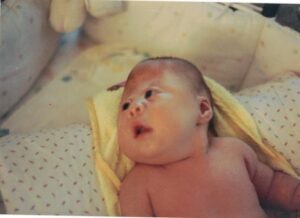For many people with a rare condition, sharing their story can be personally fulfilling—and it can help others realize that they are not alone. More so, shared stories can encourage increased research or understanding into a certain condition. For Laura Kaup, this is one of the reasons why she chose to share her experience with Carpenter syndrome: to inspire hope and connection with others.
To Laura, it is important for people to learn more about what those with rare conditions face on a daily basis: misconceptions, stigma, and difficulties with medical care. But more important is the knowledge that she is making a change and finding new ways to connect.
Recently, Laura sat down with Patient Worthy to discuss her family’s experience with Carpenter syndrome, what Carpenter syndrome is, how she manages her condition, and the importance of being an advocate within this space.
The Diagnostic Journey
Laura’s parents always knew that they wanted to have a big, happy family; she is the middle child and has six siblings. When Laura’s older brother was born, doctors noticed some potential skeletal defects, as well as craniosynostosis, which occurs when the skull bones fuse too early. Testing revealed after a few days that Laura’s brother had Carpenter syndrome.
This was a surprise to the doctors and family alike; Carpenter syndrome is an ultra-rare disorder in which only 70 cases or so have been described in medical literature. When Laura’s brother was born in 1982, he was only the 25th reported case of Carpenter syndrome worldwide. Her younger brother, who was born in 2000, was only the 40th reported case.
Since the parents already had one child with Carpenter syndrome, they knew that they were carriers of the genetic mutation. Laura shares:
“When my mom was pregnant with me, she had a feeling that I might also have Carpenter syndrome. She saw some similarities between my ultrasounds and my older brother’s ultrasounds. After bringing this up, she was referred to a specialist that could do a more detailed ultrasound.”
This ultrasound showed that Laura had extra digits/toes, which is a common trait of Carpenter syndrome. Soon after, the doctor confirmed that Laura would also have the syndrome.

Laura and her older brother’s experience with Carpenter syndrome helped the family become more educated on the impact of a rare disease, medical care, and advocacy. This served them well when Laura’s younger brother was also diagnosed. To this day, Laura credits her family as being her strongest support system and best advocates.
What is Carpenter Syndrome?
Laura describes Carpenter syndrome as:
“A rare genetic disorder that causes deformities in the head, hands, and feet. It can also cause deformities in other parts of the body such as the heart, spine, and hips. Because of how Carpenter syndrome affects the structure of the head, it is not uncommon for people to have an intellectual disability.”
RAB23 or MEGF8 gene mutations cause Carpenter syndrome. The first gene normally plays a role in how proteins and other molecules move around the cell; the latter gene is believed to play a role in normal body patterning and cell adhesion. These mutations alter body shaping and development. Symptoms and characteristics of Carpenter syndrome, outside of or adding to what Laura listed above, may include:
- Extra, short, or fused fingers and toes
- Hearing or vision loss
- Umbilical hernias
- A flat nasal bridge, downward pointing eyes, and low-set ears
- Organs in the wrong position
- Top of the head that may appear pointed or broad
- Hip deformities
- Dental abnormalities, such as an underdeveloped jaw or small teeth
- Heart defects
Laura cautions that not every person with this rare condition faces the same symptoms, severity, or outcomes. It is important to understand that these diseases are variable. She explains:
“Carpenter syndrome affects my two brothers and I all differently. Many people think that those with the same rare disorder are going to have the same symptoms or similarities, but this just isn’t true.”
Multidisciplinary care is the ideal way to manage Carpenter syndrome. Treatment tends to be focused on symptom management. Surgery may also be used to correct certain skeletal abnormalities.
Join us in Part 2 as Laura discusses how she manages her Carpenter syndrome, as well as why it is so important for her to be an advocate within this community.


